Watteau and a Souvenir of Rome
© Martin Eidelberg
Created July 2019; revised August 2019
© Martin Eidelberg
Created July 2019; revised August 2019
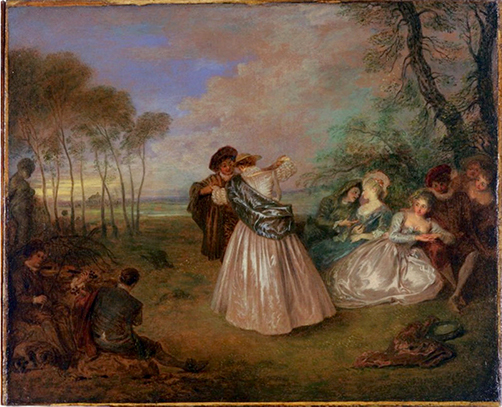 |
1. Antoine Watteau, La Contredanse, oil on canvas, 44.4 x 54.6 cm. Fine Arts Museums of San Francisco, gift of Mrs. Clarence Sterling Postley. |
Statues are found in many of Watteau’s fêtes galantes, reinforcing the idea that the verdant meadows in which his characters sit or stroll are parklands attached to stately country houses. The statues serve as a reminder that these men and women belong to a rich and affable society. Some critic have sought to read them as part of a narrative that responds to the actions of the people nearby, but Watteau was not that type of allegorical artist. As poetic as he was, he was also a realist. The sculptures he painted often represent actual works of art; some are more immediately recognizable while others are more obscure. It is one of the latter that we are concerned with: the statue of a young boy at the left side of Watteau’s La Contredanse (fig. 1).
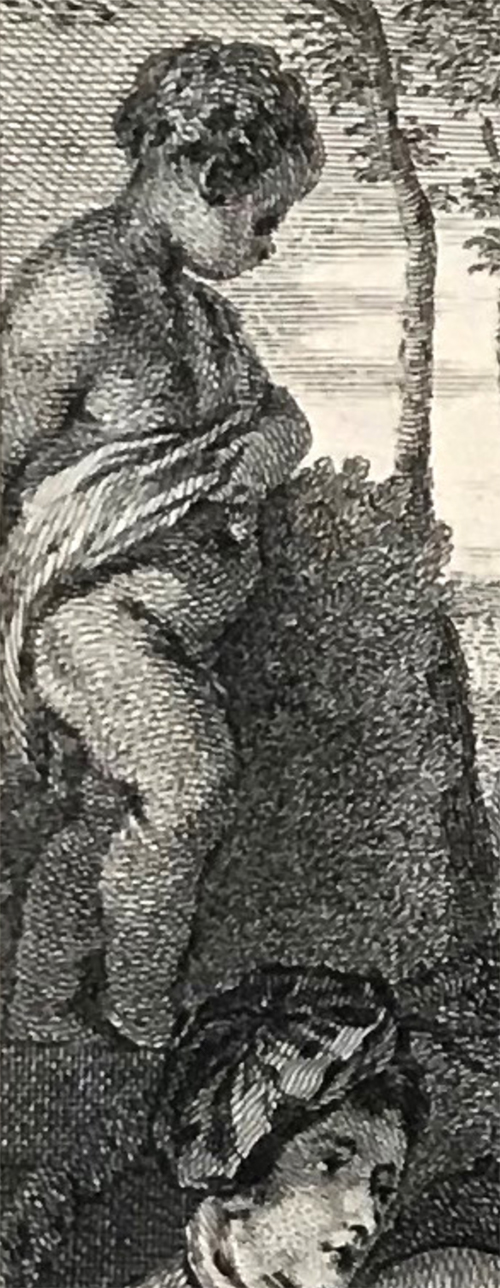 |
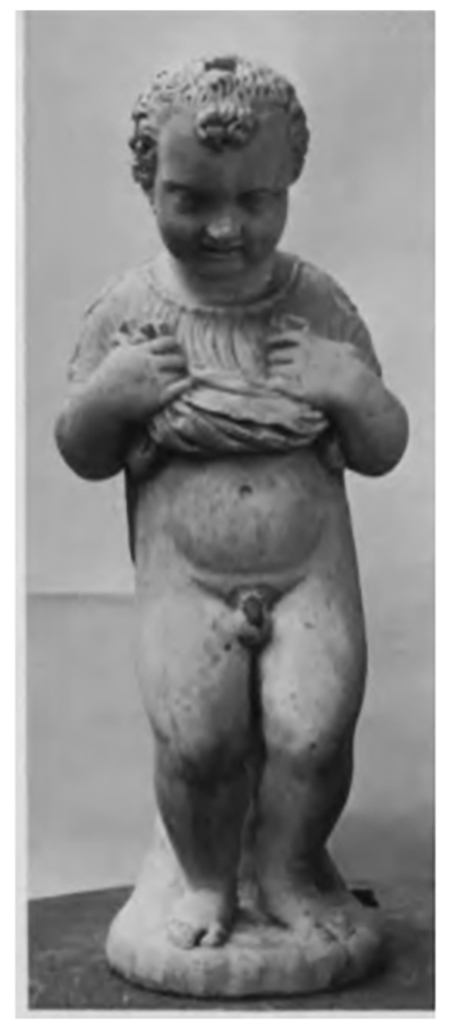 |
2. Etienne Brion after Watteau, La Contredanse (detail, here reversed to the original direction of the painting), engraving. |
3. Renaissance imitation of a Roman statue, A Boy Urinating. Paris, Musée du Louvre, Département des antiquités grecs, étrusques et romaines. |
The boy is positioned so that we see him mostly from the side. Few Watteau scholars have commented upon La Contredanse, much less on this small statue. In fact, that area of the painting is abraded and the statue is best seen in Etienne Brion’s engraving for Jean de Jullienne’s Oeuvre gravé (fig. 2). As will be demonstrated, the statue is of a classically dressed youth. Because he is seen at an oblique angle, his action is not clearly discernable but, in fact, he has bunched up his chiton and wound it around his torso to facilitate his urinating. This bodily function is not what we would expect in an otherwise poetic, ethereal scene. The graceful dancing, the musical accompaniment, the bucolic nature of the scene—all conjure up d’Urfé’s vision of shepherds and shepherdesses. A urinating boy, even if marble, seems very much out of place.
The identification of this statue proves to be the easiest part of the task. It is a statue which is now in the collection of the Louvre (fig. 3).1 Copying the essential attributes of the actual statue, Watteau has depicted the boy standing upright, but with his right leg bent at the knee and the left arm bent at the elbow, his left hand clutching the drapery. His square-shaped head and tight-fitting cap of curly hair also closely follow the statue. On the other hand, Watteau has taken certain liberties, notably dropping the garment from the right shoulder, and pulling the boy’s right arm back, since it no longer is needed to hold the absent drapery.
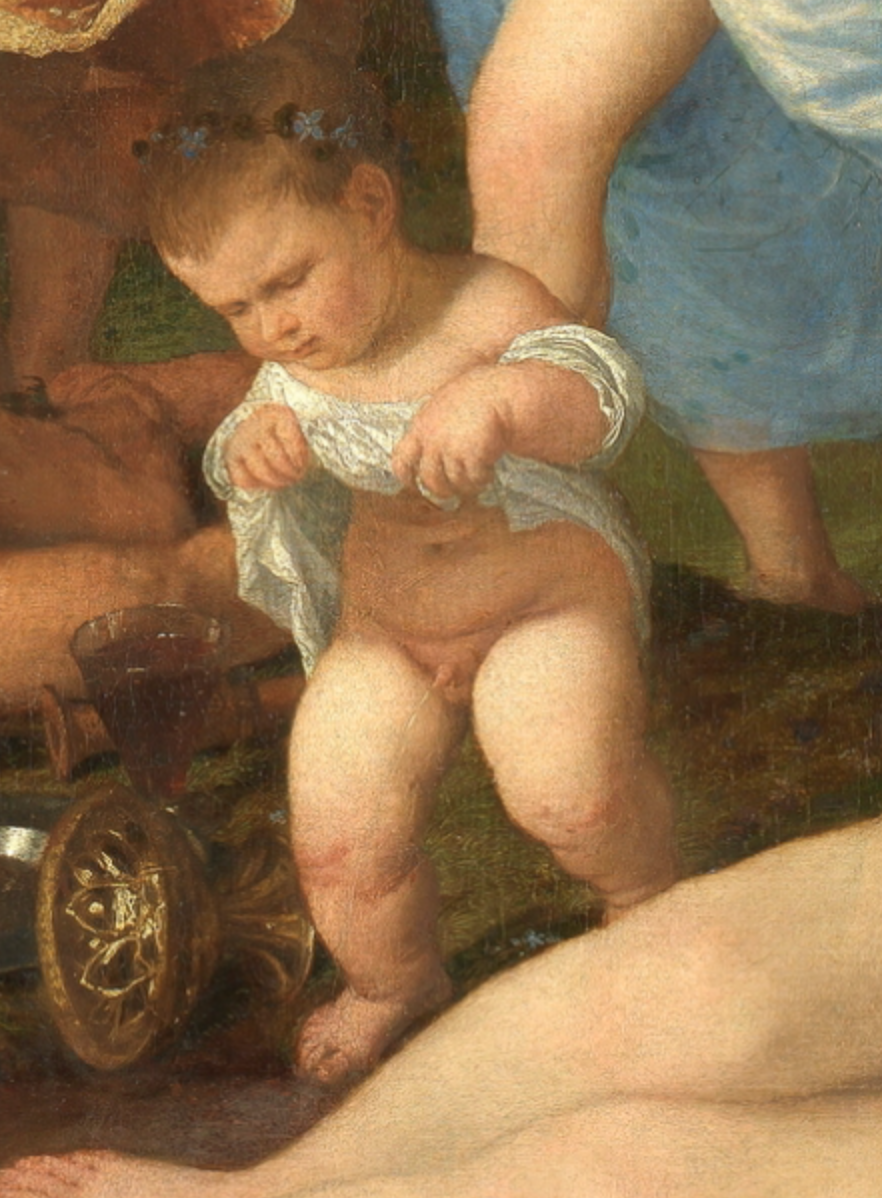 |
4. Titian, The Bacchanal of the Andrians (detail), c. 1523-26. Madrid, Museo del Prado. |
In the sixteenth and seventeenth centuries the marble was in Italy, and passed as a work from Classical Antiquity, an ascription that remained in place until recently. An unverified tradition claimed that the marble came from the famed Farnese collection of Classical sculpture in Rome. However, recent scholarship has declared that it is not a genuine Antique work but a Renaissance forgery. It would seem to have been carved in the fifteenth or early sixteenth century, probably produced before 1523, because Titian was inspired by it for the young boy in the foreground of his Bacchanal of the Andrians (fig. 4). It was still in Rome in the early seventeenth century because, as will be shown, Rubens saw it there. In Watteau’s era it was still in Rome, and the earliest indication of it being in Paris, is a century later, in the Louvre’s catalogue of 1816.2 The thrust of the question, then, shifts from the identification of the statue to how Watteau could have known it without having gone to Italy.
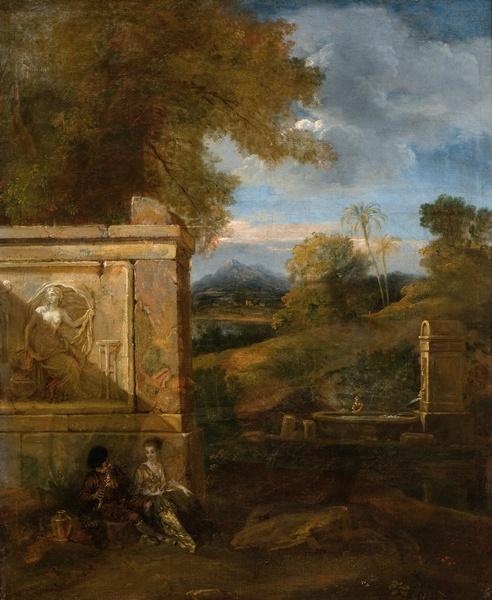 |
5. Watteau and Francisque Millet fils, Le Flûtiste, oil on canvas, 55 x 45 cm. Grenoble, Musée des beaux-arts. |
As I have shown on previous occasions, Watteau had some knowledge, howsoever limited, about Italy.3 He copied drawings of Italian sites made by his good friend Nicolas Vleughels and other colleagues, and incorporated these views in his paintings. Likewise, he knew about Roman sculpture through his colleague Francisque Millet fils, and even painted figures in one of Francisque’s landscapes which features a portion of a sarcophogus frieze that was then in Rome (fig. 5). Thus it is not inconsistent with Watteau’s practice that he added what he thought was an ancient Roman sculpture to La Contredanse.
 |
6. Willem Panneels after Rubens, Three Studies of a Statue, Copenhagen, Statens Museum for Kunst, Kongelige Kobberstiksamling. |
We believe that Watteau’s immediate source of information about this statue of a urinating boy was a drawing by Rubens. In the first decade of the seventeenth, when the young Flemish artist traveled in Italy, he recorded many of the classical statues he saw, both as part of his artistic education and with the aim of creating a source book for future reference. At that time, of course, Rubens thought the statue was antique and lavished attention on it, studying it from different angles. None of these drawings have survived but one sheet, showing the statue from three different viewpoints, was copied by his assistant, Willem Panneels (fig. 6). It is part of a collection of copies after Rubens’ drawings that Panneels gathered into an album now known as the Rubens Cantoor.4
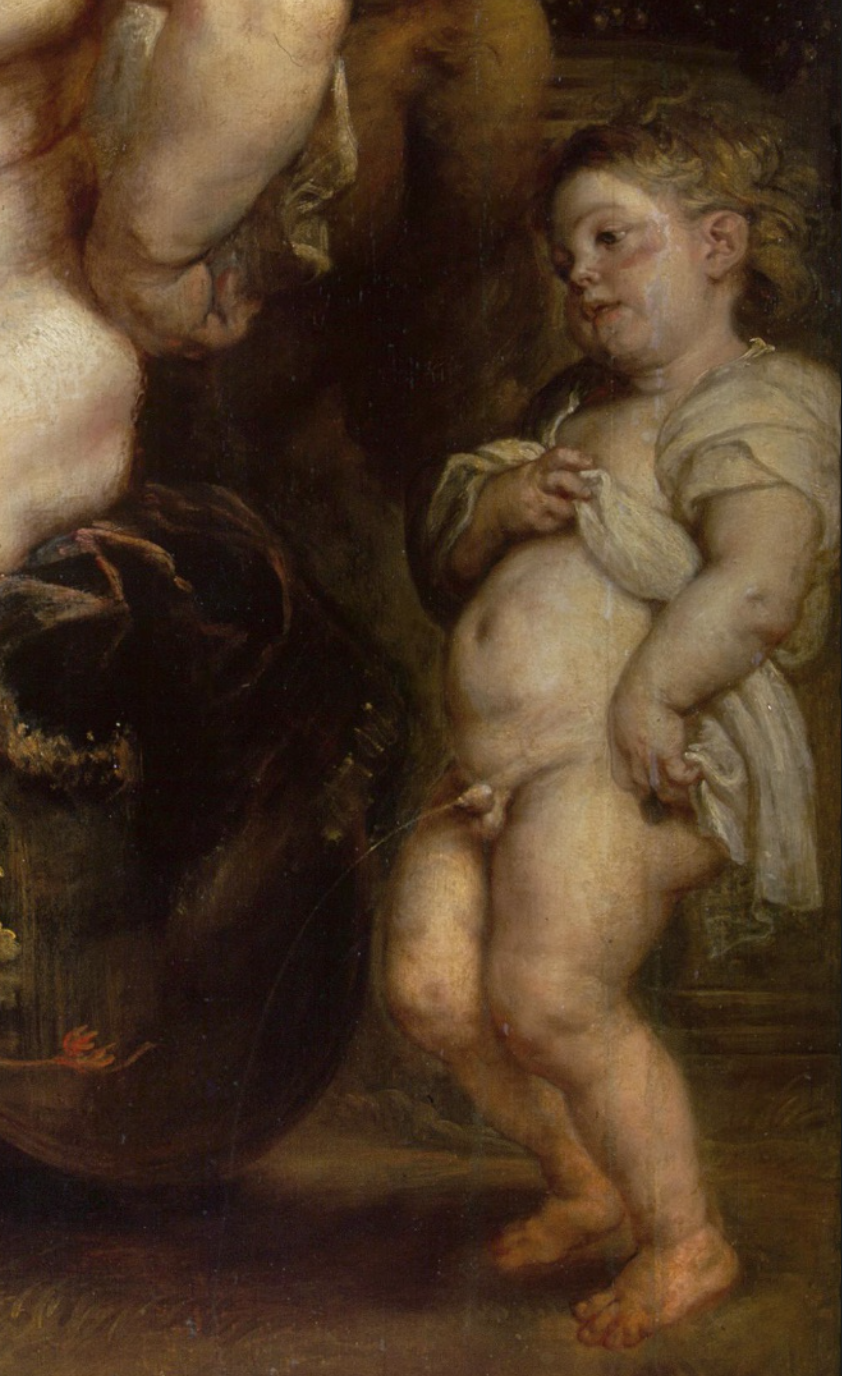 |
7. Rubens, Bacchus (detail). St. Petersburg, The Hermitage. |
Rubens was apparently fond of this statue and employed it in several paintings, often modifying the positions of the limbs.5 He transcribed the leftmost study fairly faithfully when he painted the boy in the foreground of his Bacchus, now in the Hermitage (fig. 7). There, the boy’s left arm has been changed and he actually urinates. Ironically, Watteau knew this painted figure very well since Rubens’ canvas was in Paris and was owned by his friend and patron, Antoine Crozat. Perhaps Watteau’s knowledge of this painting piqued his interest when he saw Rubens’ drawings of the statue.
None of the views of the statue in Panneel’s copy correspond to the view of the statue in La Contredanse, but it seems reasonable to assume that if Rubens saw fit to make three studies of the statue, he may have made still others to record it fully in the round. Watteau had relatively easy access to Rubens’ drawings because Crozat had assembled an enormous collections of the Flemish master’s studies. Watteau’s many copies after Rubens' drawings attest to this important aspect of his artistic development. This borrowing of Rubens’ study of the statue would be yet another instance. While some might argue that Watteau simply relied on the painting of Bacchus, turning the child around 180 degrees, this cannot be the case. Watteau knew it as a statue, and this information could not have been learnt from the painting.
What would Watteau’s contemporaries have thought about the inclusion of this statue in La Contredanse? In all probability, they would not have noticed it. That it was based on a Roman sculpture or a pseudo-Roman sculpture may well have gone unobserved by members of Watteau's and Crozat's circles, just as the presence of specific Roman sites in the backgrounds of Watteau’s fêtes galantes was overlooked by his contemporaries. Yet Watteau undoubtedly understood and was probably pleased by his reference to what he thought was a Roman environment—a land he hoped to one day enjoy himself, an elusive land of warmth and beauty, the land of dolce far niente.
NOTES
1 Musée du Louvre, Département des antiquités grecs, etrusques et romaines. See Héron de Villefosse, Marbres (Paris: 1922), 38, cat. 569.
2 Inventaire général des Muées royaux, 1816, inv. no. MR 170. We are deeply grateful to Agnes Scherer and Delphine Peschard for their generous help in penetrating the secrets of this statue.
3 Martin Eidelberg, Reveries italiennes; Watteau et les paysagistes français au XVIIIe siècle (Ghent: 2015), 29-59.
4 Jan Garff and Eva de la Fuente Pederson, Rubens Cantoor. The Drawings of Willem Panneels, 2 vols. (Copenhagen: 1988), cat. 113; also Marjon van der Meulen, Rubens. Copies after the Antique, 3 vols. (London: 1995), cat. 53.
5 Rubens employed variants of this statue in other paintings, such as his destroyed Triumph of Silenus, formerly in the Kaiser Friedrich Museum, Berlin, and a putto in the foreground of The Good Government of Marie de’Medici. In these paintings he considerably modified the positons of the youth’s arms and legs.